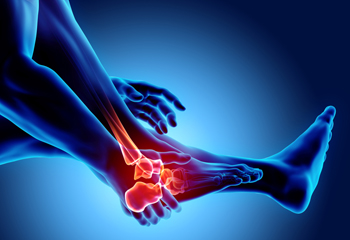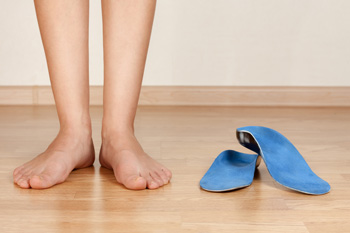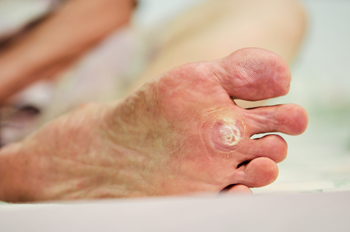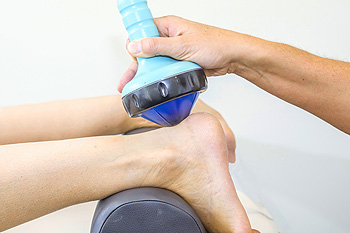Blog - Foot Doctor, Chambersburg and McConnellsburg, PA
What Is Metatarsalgia?
 Metatarsalgia is a common foot condition characterized by pain in the front of the foot. When the metatarsal bones are exposed to high levels of stress, they can become inflamed. This leads to symptoms such as sudden or gradually worsening pain in the front of the foot, and burning, aching, shooting, tingling, or a numb sensation in the foot. Metatarsalgia is often associated with other foot conditions, including Morton’s neuroma, metatarsophalangeal synovitis, avascular necrosis, sesamoiditis, and inflammatory arthritis. While anyone can develop this condition, athletes who enjoy running or other high impact sports may be more susceptible. If you have pain in the front of one or both of your feet, please seek the counsel of a podiatrist who can diagnose and treat this ailment.
Metatarsalgia is a common foot condition characterized by pain in the front of the foot. When the metatarsal bones are exposed to high levels of stress, they can become inflamed. This leads to symptoms such as sudden or gradually worsening pain in the front of the foot, and burning, aching, shooting, tingling, or a numb sensation in the foot. Metatarsalgia is often associated with other foot conditions, including Morton’s neuroma, metatarsophalangeal synovitis, avascular necrosis, sesamoiditis, and inflammatory arthritis. While anyone can develop this condition, athletes who enjoy running or other high impact sports may be more susceptible. If you have pain in the front of one or both of your feet, please seek the counsel of a podiatrist who can diagnose and treat this ailment.
Foot Pain
Foot pain can be extremely painful and debilitating. If you have a foot pain, consult with Dr. Steven Schwartz from Pennsylvania. Our doctor will assess your condition and provide you with quality foot and ankle treatment.
Causes
Foot pain is a very broad condition that could be caused by one or more ailments. The most common include:
- Bunions
- Hammertoes
- Plantar Fasciitis
- Bone Spurs
- Corns
- Tarsal Tunnel Syndrome
- Ingrown Toenails
- Arthritis (such as Gout, Rheumatoid, and Osteoarthritis)
- Flat Feet
- Injury (from stress fractures, broken toe, foot, ankle, Achilles tendon ruptures, and sprains)
- And more
Diagnosis
To figure out the cause of foot pain, podiatrists utilize several different methods. This can range from simple visual inspections and sensation tests to X-rays and MRI scans. Prior medical history, family medical history, and any recent physical traumatic events will all be taken into consideration for a proper diagnosis.
Treatment
Treatment depends upon the cause of the foot pain. Whether it is resting, staying off the foot, or having surgery; podiatrists have a number of treatment options available for foot pain.
If you have any questions, please feel free to contact our offices located in Chambersburg, and Mcconnellsburg, PA . We offer the newest diagnostic and treatment technologies for all your foot care needs.
How Appropriate Footwear Reduces the Risk of Falling for Older Adults
Because older adults often deal with balance and mobility issues, their risk of falling is increased. Proper footwear can help reduce that risk, even in those with diabetes, arthritis and neurodegenerative diseases. High heels and sling-back or backless shoes can be particularly hazardous as they reduce a person’s ability to maintain balance. While older adults with diabetes or foot pain are often more familiar with foot care practices, all older adults can benefit from contacting a podiatrist to learn more about foot and ankle health and what shoes are best for improving balance and reducing their risk of falling and serious injury.
Preventing falls among the elderly is very important. If you are older and have fallen or fear that you are prone to falling, consult with Dr. Steven Schwartz from Pennsylvania. Our doctor will assess your condition and provide you with quality advice and care.
Every 11 seconds, an elderly American is being treated in an emergency room for a fall related injury. Falls are the leading cause of head and hip injuries for those 65 and older. Due to decreases in strength, balance, senses, and lack of awareness, elderly persons are very susceptible to falling. Thankfully, there are a number of things older persons can do to prevent falls.
How to Prevent Falls
Some effective methods that older persons can do to prevent falls include:
- Enrolling in strength and balance exercise program to increase balance and strength
- Periodically having your sight and hearing checked
- Discuss any medications you have with a doctor to see if it increases the risk of falling
- Clearing the house of falling hazards and installing devices like grab bars and railings
- Utilizing a walker or cane
- Wearing shoes that provide good support and cushioning
- Talking to family members about falling and increasing awareness
Falling can be a traumatic and embarrassing experience for elderly persons; this can make them less willing to leave the house, and less willing to talk to someone about their fears of falling. Doing such things, however, will increase the likelihood of tripping or losing one’s balance. Knowing the causes of falling and how to prevent them is the best way to mitigate the risk of serious injury.
If you have any questions, please feel free to contact our offices located in Chambersburg, and Mcconnellsburg, PA . We offer the newest diagnostic and treatment technologies for all your foot care needs.
What is Extracorporeal Shock Wave Therapy?
For people suffering with chronic plantar fasciitis which has not responded to traditional treatment, Extracorporeal Shock Wave Therapy may be an option. Extracorporeal refers to something outside of the body, and in this case, Extracorporeal Shock Wave Therapy (ESWT) is a non-invasive alternative to surgery that may offer relief. In ESWT, ultrasound is used to find the location of the damage to the plantar fascia, and a calibrated current of shock waves is targeted directly into this area to facilitate the creation of new tissue cells and eventual healing. Contact a podiatrist to see if you may be a good candidate for ESWT.
Shockwave therapy is a treatment commonly used to treat various injuries and conditions, particularly plantar fasciitis in the feet. To learn more, consult with Dr. Steven Schwartz from Pennsylvania. Our doctor can provide the care you need to keep you pain-free and on your feet.
Shockwave Therapy
Shockwave therapy is a new treatment option designed to treat bone conditions such as tennis elbow, shoulder pain, and others. Shockwave therapy uses high intensity sound waves that are directed to the affected tissues of the body with pinpoint accuracy. The effects are very beneficial, leading to a production of collagen fibers, eliminating inflammation.
Who Benefits from Shockwave?
Shockwave is recommended for patients suffering from heel pain and associated problems. Heel pain is a common condition which can be caused by obesity, overexertion, and spending a substantial amount of time on hard floors with your feet exposed and unsupported.
Fast and Easy
The therapy is actually a simple process that can leave patients feeling better the very next day. Shockwave therapy is not as dramatic as it sounds. It enables more blood flow to effected areas, addressing the source of the problem and allowing treatment to last for a long time.
Treatment & Recovery Time
Shockwave treatment will enable your feet to recover quickly. This is especially important since surgery is not required. It is cost effective and does not require the use of anesthesia. This treatment is a better option to surgery, since it is proven safe.
If you have any questions, please feel free to contact our offices located in Chambersburg, and Mcconnellsburg, PA . We offer the newest diagnostic and treatment technologies for all your foot and ankle needs.
What is the Difference Between Flexible Flatfoot and Rigid Flatfoot?
There are two types of pes planus, or flatfoot: flexible flatfoot and rigid flatfoot. For an individual with flexible flatfoot, their arches are normal when they are sitting or on their tiptoes, but collapse when they stand. With rigid flatfoot, the arch of the foot remains flattened despite the foot’s position. Flexible flatfoot in children is normal because arches usually develop between the ages of 7-10. Flexible flatfoot that does not go away as an adult is usually due to heredity and—like childhood flexible flatfoot—can be asymptomatic with no need for treatment. Rigid flatfoot in either children, teens, or adults can be indicative of a structural issue or misalignment due to a congenital disorder or injury and should be examined and treated by a podiatrist.
Flatfoot is a condition many people suffer from. If you have flat feet, contact Dr. Steven Schwartz from Pennsylvania. Our doctor will treat your foot and ankle needs.
What Are Flat Feet?
Flatfoot is a condition in which the arch of the foot is depressed and the sole of the foot is almost completely in contact with the ground. About 20-30% of the population generally has flat feet because their arches never formed during growth.
Conditions & Problems:
Having flat feet makes it difficult to run or walk because of the stress placed on the ankles.
Alignment – The general alignment of your legs can be disrupted, because the ankles move inward which can cause major discomfort.
Knees – If you have complications with your knees, flat feet can be a contributor to arthritis in that area.
Symptoms
- Pain around the heel or arch area
- Trouble standing on the tip toe
- Swelling around the inside of the ankle
- Flat look to one or both feet
- Having your shoes feel uneven when worn
Treatment
If you are experiencing pain and stress on the foot you may weaken the posterior tibial tendon, which runs around the inside of the ankle.
If you have any questions please feel free to contact our offices located in Chambersburg, and Mcconnellsburg, PA . We offer the newest diagnostic and treatment technologies for all your foot and ankle needs.
Rheumatoid Arthritis in the Feet
 Rheumatoid arthritis is an autoimmune disease in which the body’s immune system attacks healthy joints and surrounding tissues. This leads to joint stiffness, inflammation, swelling, and pain. Rheumatoid arthritis often affects the joints of the feet and ankles. Although this is a chronic condition and does not have a cure, rheumatoid arthritis can be treated, and its symptoms can be managed. If your arthritis affects your feet and ankles, your podiatrist can help by prescribing custom orthotics, recommending exercises, and suggesting lifestyle modifications that may reduce the symptoms of rheumatoid arthritis.
Rheumatoid arthritis is an autoimmune disease in which the body’s immune system attacks healthy joints and surrounding tissues. This leads to joint stiffness, inflammation, swelling, and pain. Rheumatoid arthritis often affects the joints of the feet and ankles. Although this is a chronic condition and does not have a cure, rheumatoid arthritis can be treated, and its symptoms can be managed. If your arthritis affects your feet and ankles, your podiatrist can help by prescribing custom orthotics, recommending exercises, and suggesting lifestyle modifications that may reduce the symptoms of rheumatoid arthritis.
Because RA affects more than just your joints, including the joints in your feet and ankles, it is important to seek early diagnosis from your podiatrist if you feel like the pain in your feet might be caused by RA. For more information, contact Dr. Steven Schwartz of Pennsylvania. Our doctor will assist you with all of your podiatric concerns.
What Is Rheumatoid Arthritis?
Rheumatoid Arthritis (RA) is an autoimmune disorder in which the body’s own immune system attacks the membranes surrounding the joints. Inflammation of the lining and eventually the destruction of the joint’s cartilage and bone occur, causing severe pain and immobility.
Rheumatoid Arthritis of the Feet
Although RA usually attacks multiple bones and joints throughout the entire body, almost 90 percent of cases result in pain in the foot or ankle area.
Symptoms
- Swelling and pain in the feet
- Stiffness in the feet
- Pain on the ball or sole of feet
- Joint shift and deformation
Diagnosis
Quick diagnosis of RA in the feet is important so that the podiatrist can treat the area effectively. Your doctor will ask you about your medical history, occupation, and lifestyle to determine the origin of the condition. Rheumatoid Factor tests help to determine if someone is affected by the disease.
If you have any questions please feel free to contact our offices located in Chambersburg, and Mcconnellsburg, PA . We offer the newest diagnostic and treatment technologies for all your foot and ankle needs.
Types Orthotics for Foot and Ankle Pain
 Orthotics are specialized shoes or heel inserts that are made to treat various foot and ankle problems. They can be bought over the counter at major retailers or be custom-made by a podiatrist. Different types of orthotics are designed to treat different types of foot and ankle problems. Full support shoe orthotics, such as orthotic inserts, splints, and traction devices, are useful for patients who have injuries associated with overuse, stress, or arthritis. Heel pads are a type of orthotic often used to correct foot overpronation, a type of gait where the foot rolls inward while standing or walking. Traction shoes or traction ankle supports are orthotic devices used to reduce pain and swelling from conditions such as bunions or ankle sprains. To see if orthotics are right for you, please consult with a podiatrist.
Orthotics are specialized shoes or heel inserts that are made to treat various foot and ankle problems. They can be bought over the counter at major retailers or be custom-made by a podiatrist. Different types of orthotics are designed to treat different types of foot and ankle problems. Full support shoe orthotics, such as orthotic inserts, splints, and traction devices, are useful for patients who have injuries associated with overuse, stress, or arthritis. Heel pads are a type of orthotic often used to correct foot overpronation, a type of gait where the foot rolls inward while standing or walking. Traction shoes or traction ankle supports are orthotic devices used to reduce pain and swelling from conditions such as bunions or ankle sprains. To see if orthotics are right for you, please consult with a podiatrist.
If you are having discomfort in your feet and would like to try orthotics, contact Dr. Steven Schwartz from Pennsylvania. Our doctor can provide the care you need to keep you pain-free and on your feet.
What Are Orthotics?
Orthotics are inserts you can place into your shoes to help with a variety of foot problems such as flat feet or foot pain. Orthotics provide relief and comfort for minor foot and heel pain but can’t correct serious biomechanical problems in your feet.
Over-the-Counter Inserts
Orthotics come in a wide variety of over-the-counter inserts that are used to treat foot pain, heel pain, and minor problems. For example, arch supports can be inserted into your shoes to help correct overarched or flat feet, while gel insoles are often used because they provide comfort and relief from foot and heel pain by alleviating pressure.
Prescription Orthotics
If over-the-counter inserts don’t work for you or if you have a more severe foot concern, it is possible to have your podiatrist prescribe custom orthotics. These high-quality inserts are designed to treat problems such as abnormal motion, plantar fasciitis, and severe forms of heel pain. They can even be used to help patients suffering from diabetes by treating foot ulcers and painful calluses and are usually molded to your feet individually, which allows them to provide full support and comfort.
If you are experiencing minor to severe foot or heel pain, it’s recommended to speak with your podiatrist about the possibilities of using orthotics. A podiatrist can determine which type of orthotic is right for you and allow you to take the first steps towards being pain-free.
If you have any questions please contact our offices located in Chambersburg, and Mcconnellsburg, PA . We offer the newest diagnostic and treatment technologies for all your foot and ankle needs.
What Causes Heel Fissures?
 Heel fissures are cracks in the skin of the heels that can be painful and uncomfortable. There are many potential causes of heel fissures such as standing for prolonged periods of time. The effects of prolonged standing can be mitigated by wearing shoes that are supportive and padded in the heel area. Skin conditions, such as eczema, atopic dermatitis, psoriasis, and palmoplantar keratoderma, can all affect the skin of the heels by making them dry, scaly, or thickened, and therefore more likely to crack. You may also develop cracked heels as the result of wearing inappropriate footwear. Shoes that are backless can cause or worsen cracked heels because there is nothing to keep the back of the foot in place while pressure is exerted on it from walking or standing. The extra pressure on the foot can cause dry skin on the heels to crack. If you have painful cracked heels, it is recommended that you see a podiatrist for treatment.
Heel fissures are cracks in the skin of the heels that can be painful and uncomfortable. There are many potential causes of heel fissures such as standing for prolonged periods of time. The effects of prolonged standing can be mitigated by wearing shoes that are supportive and padded in the heel area. Skin conditions, such as eczema, atopic dermatitis, psoriasis, and palmoplantar keratoderma, can all affect the skin of the heels by making them dry, scaly, or thickened, and therefore more likely to crack. You may also develop cracked heels as the result of wearing inappropriate footwear. Shoes that are backless can cause or worsen cracked heels because there is nothing to keep the back of the foot in place while pressure is exerted on it from walking or standing. The extra pressure on the foot can cause dry skin on the heels to crack. If you have painful cracked heels, it is recommended that you see a podiatrist for treatment.
Cracked heels are unsightly and can cause further damage to your shoes and feet. If you have any concerns, contact Dr. Steven Schwartz from Pennsylvania. Our doctor can provide the care you need to keep you pain-free and on your feet.
Cracked Heels
Cracked heels appear unappealing and can make it harder for you walk around in sandals. Aside from looking unpleasant, cracked heels can also tear stockings, socks, and wear out your shoes. There are several methods to help restore a cracked heel and prevent further damage.
How Do You Get Them?
Dry skin is the number one culprit in creating cracked heels. Many athletes, walkers, joggers, and even swimmers suffer from cracked heels. Age and skin oil production play a role to getting cracked heels as well.
Promote Healing
Over the counter medicines can help, especially for those that need instant relief or who suffer from chronic dry feet.
Wear Socks – Wearing socks with medicated creams helps lock in moisture.
Moisturizers – Applying both day and night will help alleviate dryness which causes cracking.
Pumice Stones – These exfoliate and remove dead skin, which allows for smoother moisturizer application and better absorption into the skin.
Change in Diet
Eating healthy with a well-balanced diet will give the skin a fresh and radiant look. Your body responds to the kinds of food you ingest. Omega-3 fatty acids and zinc supplements can also revitalize skin tissue.
Most importantly, seek professional help if unsure how to proceed in treating cracked heels. A podiatrist will help you with any questions or information needed.
If you have any questions, please feel free to contact our offices located in Chambersburg, and Mcconnellsburg, PA . We offer the newest diagnostic and treatment technologies for all your foot care needs.
How Plantar Warts Can Rub You the Wrong Way
 Certain strains of Human Papillomavirus (HPV) can produce individual or clustered plantar warts on the sole of the foot where there is friction or pressure. Although harmless, these small and flat lesions can be uncomfortable or even painful. Plantar warts are contagious and can spread from person to person in communal spaces like public showers. They are most common in 12-16 year olds, and people most at risk for plantar warts have weakened immune systems, or cuts or scrapes on their feet. These warts can eventually disappear, but it may take years for them to do so. Home remedies for pain relief or removal may be tempting, but they can be ineffective or even risky. For professional treatment, consult with a podiatrist who has many effective and safe ways to remove or resolve plantar warts.
Certain strains of Human Papillomavirus (HPV) can produce individual or clustered plantar warts on the sole of the foot where there is friction or pressure. Although harmless, these small and flat lesions can be uncomfortable or even painful. Plantar warts are contagious and can spread from person to person in communal spaces like public showers. They are most common in 12-16 year olds, and people most at risk for plantar warts have weakened immune systems, or cuts or scrapes on their feet. These warts can eventually disappear, but it may take years for them to do so. Home remedies for pain relief or removal may be tempting, but they can be ineffective or even risky. For professional treatment, consult with a podiatrist who has many effective and safe ways to remove or resolve plantar warts.
Plantar warts can be very uncomfortable. If you need your feet checked, contact Dr. Steven Schwartz from Pennsylvania. Our doctor will assist you with all of your foot and ankle needs.
About Plantar Warts
Plantar warts are the result of HPV, or human papillomavirus, getting into open wounds on the feet. They are mostly found on the heels or balls of the feet.
While plantar warts are generally harmless, those experiencing excessive pain or those suffering from diabetes or a compromised immune system require immediate medical care. Plantar warts are easily diagnosed, usually through scraping off a bit of rough skin or by getting a biopsy.
Symptoms
- Lesions on the bottom of your feet, usually rough and grainy
- Hard or thick callused spots
- Wart seeds, which are small clotted blood vessels that look like little black spots
- Pain, discomfort, or tenderness of your feet when walking or standing
Treatment
- Freezing
- Electric tool removal
- Laser Treatment
- Topical Creams (prescription only)
- Over-the-counter medications
To help prevent developing plantar warts, avoid walking barefoot over abrasive surfaces that can cause cuts or wounds for HPV to get into. Avoiding direct contact with other warts, as well as not picking or rubbing existing warts, can help prevent the further spread of plantar warts. However, if you think you have developed plantar warts, speak to your podiatrist. He or she can diagnose the warts on your feet and recommend the appropriate treatment options.
If you have any questions please feel free to contact our offices located in Chambersburg, and Mcconnellsburg, PA . We offer the newest diagnostic and treatment technologies for all your foot and ankle needs.






